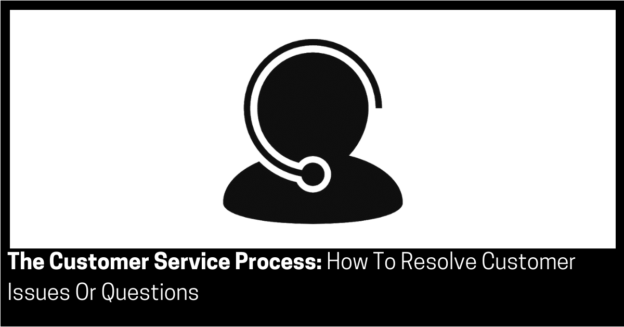Customer Service is important because it allows your brand to:
- Build goodwill with prospects and customers;
- Manage its reputation;
- Reduce buyer’s remorse;
- Retain prospects and customers;
- Conduct defacto market research and fill product gaps and create new products;
- Upsell, next sell and cross sell other products, services or solutions;
- And much, much more…
Customer service or a help desk is a function of a brand that provides information and support to users.
The Customer Service Process has the following 6 Steps:
- STEP 1: Issue Or Question;
- STEP 2: Listen;
- STEP 4: Respond;
- STEP 4: Escalate;
- STEP 5: Resolve; and
- STEP 6: Communicate Back.
Let’s start with…
1) Issue Or Question
The first step starts when an issue or question is raised.
An issue or question is communicated to you by a prospect or customer.
When this happens, customer service starts.
This leads to listening to the prospects or customers issue or question.
2) Listen
The second step is listening to the prospects or customers issue or question.
Customer Service listens to the prospects or customers issue or question.
If it is an issue, sometimes the act of listening simply resolves the issue by way of allowing venting.
If venting does not resolve it alone or it is a question, then listening leads to responding to the prospects or customers issue or question.
If the issue or question has no legitimacy, then there is no need to answer it – don’t feed the trolls!
In addition, the Customer Service rep should be searching externally, proactively for feedback, so they can proactively address it or use it for testimonials and referrals.
3) Respond
The third step is responding to the prospects or customers issue or question.
It should always be acknowledged and agreed with, even if it is “untrue.”
There is an old retail saying that goes like this: “the customer is always right.”
And they are…in their own head.
It’s really hard for someone to change their mind.
If the issue or question can be solved on the spot, customer service should solve it then and there for the prospect or customers.
If the issue or question cannot be solved on the spot, customer service should communicate to the prospect or customers that it cannot be solve, BUT they will be in contact with an answer.
All communication should be within 12 hours.
Customer Service should send the issue or question to either the:
- Customer Service Team;
- Product Team; or
- Sales Team.
…Depending on its nature.
The Customer Service Team deals with issues or problems.
The Product Team deals with product and service related questions.
The Sales team deals with new product or service conversion.
This leads to escalating the prospects or customers issue or question to your Customer Service or Product Team, if necessary.
4) Escalate
The fourth step is escalating the prospects or customers issue or question to your Customer Service, Product Team or Sales Team, if necessary.
If it is a Customers service issue, it will be sent to the Customers Service Team.
If it is a Product question, it will be sent to the Product Team.
If it is a sales question, it will be sent to the Sales Team.
This leads to resolution of the prospects or customers issue or question.
5) Resolve
The fifth step is resolution of the prospects or customers issue or question.
If it is a Customers Service issue, the Customers Service Team will solve the issue and communicate back to the prospect or customer the issue and how it was resolved.
If it is a Product question, the Product Team will see if it is a product fault.
If it is a Sales question, the Sales Team will sell to the prospect.
If it was a product fault, the Product Team will:
- Refund;
- Return;
- Resupply;
- Return; and/or
- Resupply.
Depending on your Life Time Value of a customer, it’s usually far cheaper in the long run to do any of these than not.
Remember “the customer is always right.”
This leads to communicating back to the prospects or customers about their issue or question.
6) Communicate Back
The last step is communicating back to the prospects or customers about their issue or question.
If it was not a product fault, they will communicated back to the prospect or customer.
If it was not a product fault, the Product Team will communicate back to the prospect or customer the result.
All communication should be within 24 hours.
That’s it.

